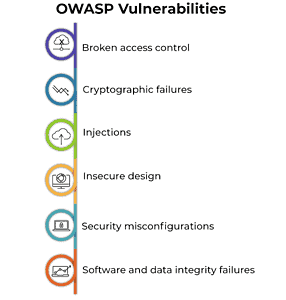[Author’s Note] The following was part of my testing of artificial intelligence (specifically ChatGPT’s) ability to write technical blog posts and also create training materials for developers to better understand secure coding practices. I used ChatGPT 4.0 for this and may go back and refine the prompts I used to get more complex examples, but this is not a bad start. I wanted to share this as an example of what can be accomplished using these tools.
[Written by Artificial Intelligence]: A Deep Dive into 3 OWASP Top 10 Vulnerabilities in a Web Application: Examples, Detection, and Remediation
Introduction
Web application security is a critical aspect of modern software development, and understanding the common vulnerabilities that web applications face is essential. The Open Web Application Security Project (OWASP) maintains the OWASP Top 10 Project, a list of the most critical security risks in web applications.
In this blog post, we will examine a simple web application built using HTML, JavaScript, PHP 8, and a MySQL database. We will identify three examples of OWASP Top 10 vulnerabilities, show you how to spot them, and provide guidance on how to fix these issues.
Let’s start by looking at the example web application code:
index.html
<!DOCTYPE html>
<html lang="en">
<head>
<meta charset="UTF-8">
<title>OWASP Top 10 Vulnerabilities Example</title>
<script src="script.js"></script>
</head>
<body>
<h1>Log in</h1>
<form method="post" action="login.php">
<label for="username">Username:</label>
<input type="text" id="username" name="username">
<br>
<label for="password">Password:</label>
<input type="password" id="password" name="password">
<br>
<input type="submit" value="Log in">
</form>
</body>
</html>script.js
// script.js
function validateForm() {
var username = document.forms["login"]["username"].value;
var password = document.forms["login"]["password"].value;
if (username === "" || password === "") {
alert("Both fields are required");
return false;
}
}login.php
// login.php
<?php
$conn = new mysqli("localhost", "user", "password", "database");
$username = $_POST["username"];
$password = $_POST["password"];
$sql = "SELECT * FROM users WHERE username = '$username' AND password = '$password'";
$result = $conn->query($sql);
if ($result->num_rows > 0) {
header("Location: dashboard.php");
} else {
echo "Invalid username or password";
}
$conn->close();
?>Findings and Remediation
SQL Injection (Injection)
Vulnerability: In the login.php file, user input is directly used in the SQL query without proper sanitization or parameterization. This allows an attacker to inject malicious SQL code, potentially gaining unauthorized access or modifying the database.
How to spot: Look for instances where user input is directly concatenated into SQL queries.
Remediation: Use prepared statements with parameterized queries to prevent SQL injection. Update the code as follows:
// login.php (fixed)
<?php
$conn = new mysqli("localhost", "user", "password", "database");
$username = $_POST["username"];
$password = $_POST["password"];
$stmt = $conn->prepare("SELECT * FROM users WHERE username = ? AND password = ?");
$stmt->bind_param("ss", $username, $password);
$stmt->execute();
$result = $stmt->get_result();
if ($result->num_rows > 0) {
header("Location: dashboard.php");
} else {
echo "Invalid username or password";
}
$stmt->close();
$conn->close();
?>Cross-Site Scripting (XSS)
Vulnerability: In the JavaScript file (script.js), an alert function displays an error message based on user input without proper sanitization. This allows an attacker to inject malicious scripts that could execute in the context of the victim’s browser.
How to spot: Look for instances where user input is directly included in the output without proper encoding or validation.
Remediation: Use proper output encoding or escaping to prevent XSS attacks. Update the JavaScript code as follows:
// script.js (fixed)
function validateForm() {
var username = document.forms["login"]["username"].value;
var password = document.forms["login"]["password"].value;
if (username === "" || password === "") {
var errorMsg = document.createElement("p");
errorMsg.textContent = "Both fields are required";
errorMsg.style.color = "red";
document.body.appendChild(errorMsg);
return false;
}
}Sensitive Data Exposure
Vulnerability: The example web application transmits user data, such as usernames and passwords, without encryption. This makes it vulnerable to eavesdropping and man-in-the-middle attacks, potentially leading to unauthorized access to sensitive information.
How to spot: Check if sensitive data is transmitted over unencrypted channels or if data is stored without proper encryption.
Remediation: Use HTTPS to encrypt data during transmission and store sensitive data securely using encryption and hashing techniques. Additionally, update the login form to use HTTPS:
<!-- Updated form action to use HTTPS -->
<form method="post" action="https://yourdomain.com/login.php">Conclusion
In this blog post, we examined a simple web application and identified three OWASP Top 10 vulnerabilities. We explained how to spot these vulnerabilities and provided guidance on how to remediate them. It’s essential for developers to familiarize themselves with the OWASP Top 10 list and continuously update their knowledge as new threats emerge.
By following secure coding practices and performing regular security reviews, you can significantly reduce the risk of security vulnerabilities in your web applications. Remember, security is not a one-time task but an ongoing process that requires constant vigilance.
For more information on the OWASP Top 10 Project and other web application security best practices, visit the OWASP Foundation website.





